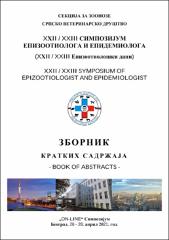| dc.description.abstract | Equid alphaherpesvirus 1 (formerly equine herpesvirus 1 - EHV-1) is one of the most significant and widespread viral pathogens in horses. The virus primarily causes respiratory disease, but viremia and its spread to other organs often lead to other clinical manifestations of the disease, primarily abortion and the development of neurological symptoms. Recently, infections caused by neuropathogenic strains of EHV-1 that cause equine herpesvirus myeloencephalopathy (EHM) have become more common. The latest epizootic of the highly pathogenic EHV-1 virus that causes EHM, also recorded for the first time in Europe, was detested in early February 2021 during a horse race in Valencia, Spain, and spread very quickly to a number of European countries.
The subject of this case report is a health disorder in an equestrian club with about 20 horses. The outbreak of the disease was preceded by the introduction of a new animal (mare) into the club on December 15, 2020, which neither then, nor later showed clinical signs of the disease. The first symptoms of the disease were recorded on December 25 in one mare (the mare fell and could not get up, the hind legs were paralyzed, consciousness was preserved as well as the desire to take food and water). On the same day, other animals show signs of uncoordinated movement, weakness of the legs, uncoordinated movements of the eyeballs, shearing ears and greatly dilated pupils. This animal did not fall and with supportive therapy it overcame the infection. From December 25, daily measurement of body temperature is introduced, which is carried out until the end of January 2021 - a total of 7 horses had a high temperature. Clinical symptoms also include leaning the head against the wall and circular movements of the animals around the hind legs, and both foals aborted in the last trimester of pregnancy. Three horses died (2 euthanized; the last death was on January 28, 2021). Horses that remained on their feet recovered, and those that fell eventually died / were euthanized.
In the laboratory, the presence of EHV1, EHV4, EVA and equine influenza viruses were performed by real-time RT-PCR method, as well as the presence of antibodies against these viruses was tested by VNT and HI test. The first samples from December 30, 2020 - nasal swabs of 4 horses with a clinical signs gave a positive result in 2 samples for EHV-1. During January, the EHV-1 was detected in both the aborted fetus and in the cerebrospinal fluid of the euthanized mare, and it was also isolated on the RK-13 cell line. A negative result was obtained for all other viruses tested. Serological tests conducted about a month after the appearance of the first symptoms of the disease determined a high titer of antibodies against the EHV-1 in all individuals in the equestrian club.
Occurrence of enzootic EHV-1 EHM virus infection has been present in Serbia since the end of 2020 - the origin of the virus is unknown. The detected EHV-1 showed high pathogenicity and speed of spreading among horses and indicates a possible tendency of further spread in Serbia. The appearance of this EHV-1 infection, as well as the possibility of its further spread, indicates the need to draft certain law documents in order to adequately support the control of horse health in Serbia.
Keywords: EHV-1, EHM strain, disease outbreak, Serbia | en_US |

